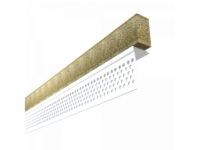The Future of Fire-Rated Building Materials
Revolutionary sustainable plywood that challenges flames and prioritizes safety

Photo courtesy of Garnica
We all know the importance of fire safety in the workplace and in our homes. Utilizing fire-retardant materials is an effective method for containing and controlling potential fires.
But what exactly is a fire-retardant material, and how does it work?
In essence, fire-retardant materials are designed to resist spreading fire from one area to another. Traditionally, they have been made from metals, plastics and composites, and now, thanks to the innovative minds at Garnica, sustainable plywood.
Garnica, a global leader in manufacturing premium sustainable plywood, recognized the need for fire-retardant building materials and created a revolutionary line of machinable plywood called Fireshield, sourced from farm-grown poplar (agroforestry) from Spain and France. These treated plywood panels range in size from 4 feet by 8 feet up to 5 feet by 10 feet. The larger size is ideal for building elevators, which require lightweight and fire-retardant construction materials.
The innovative Fireshield plywood does not burn and meets the highest fire regulations in the industry: ASTM E-84 Class A and CAN/ULC S102-10. Fireshield building panels can be used indoors for structures and door frames, floors, walls, ceilings and even furniture. These materials can also help reduce the damage caused by fire, including direct damage from the flames and smoke and indirect damage caused by the water used to extinguish the fire.
This specially treated plywood works by limiting the amount of heat released, which can help protect other parts of the building from being damaged by fire. Fireshield undergoes annual efficacy tests to ensure the product maintains the highest standards.
How are these panels made?
Unlike traditional MDFs and plywood used in construction that rely on a fire-retardant coating, Garnica Fireshield veneers are individually soaked in a proprietary treatment before they’re dried, glued and compressed to create plywood panels. This process ensures the panels can be sanded or machined in any configuration and will still retain their fire-retardant rating of 100 percent. Yes, the process is painstaking and methodical, but the result is a treated plywood that does not burn, no matter how one slices and dices the panel. Literally.
The product significantly reduces the carbonization rate, smoke generation and flame propagation. Additionally, it has no fallout from falling flames, which means a far lower chance of fire spreading to other surfaces. Currently, this is the only product on the market to retain its fire rating, even after machining or sanding.

Photo courtesy of Garnica
Designers, architects and builders alike can appreciate the adaptability of plywood: it is ideal for millwork, unlike other fire-retardant build materials, such as concrete, brick and glass. Fireshield is perfect for customized, stylish and fire-rated applications of cabinetry used in kitchens, where most residential fires start. According to the National Fire Prevention Association, 50 percent of all household fires are cooking-related and begin in the kitchen. Imagine how much safer homes would be if cabinetry did not burn. Ever.
Fire-retardant materials are critical components of construction projects, as they aid in protecting buildings and their occupants from the devastation caused by fires. Carefully selecting the appropriate type of fire-retardant material is crucial for optimal protection. By understanding how these products function, architects, designers and builders can make informed decisions on which option is best suited for each project and client. With the recent introduction of fire-retardant plywood as a material option, architects and designers have greater flexibility and design opportunities while prioritizing safety. Garnica’s Fireshield may be more expensive than other fire-rated materials, but when it comes to the safety of people’s homes and workplaces, it’s a small price to pay.
To learn more, watch this video.
Looking for a reprint of this article?
From high-res PDFs to custom plaques, order your copy today!






